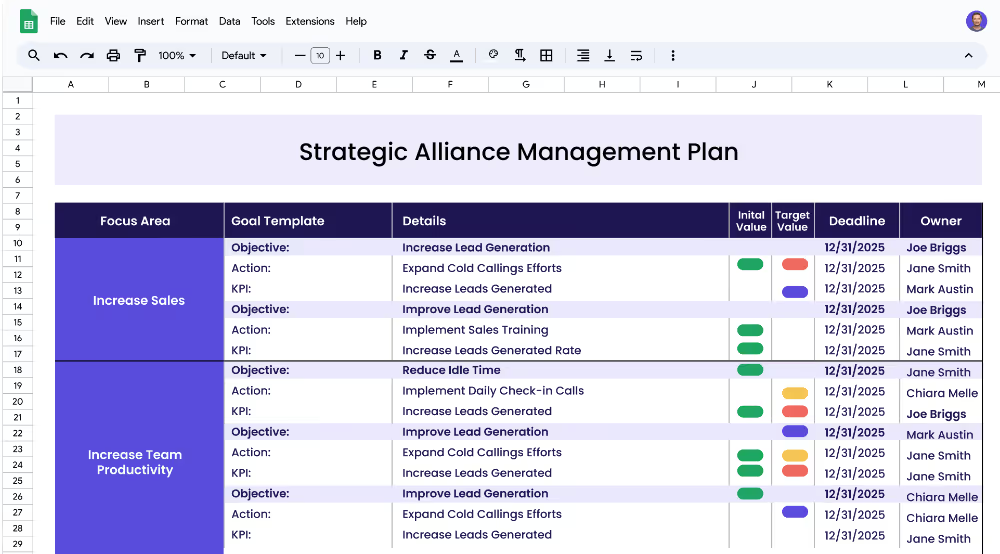A strategic alliance management plan outlines how a business or organization will manage their strategic alliances. It includes the goals, objectives, and strategies for developing and maintaining successful relationships with partners. The plan should also include measurable targets and KPIs to measure progress and track performance. The plan should be regularly reviewed and updated to reflect any changes in the organization's goals or alliances.
Each focus area has its own objectives, projects, and KPIs to ensure that the strategy is comprehensive and effective.
This strategic alliance management plan template is suitable for any business or organization looking to create a strategy to manage their strategic alliances. It can be used to create a plan that is tailored to the organization's specific needs and goals. The template is designed to be easily customizable and can be adapted to meet the needs of any organization.
The first step in creating a strategic alliance management plan is to define the focus areas. Focus areas are broad topics that will be the focus of the plan and include the objectives, actions, and measures that need to be taken in order to achieve the goals of the plan. Examples of focus areas might include strengthening relationships, monitoring performance, or leveraging strategic alliances.
Once the focus areas have been defined, it is important to identify specific objectives for each focus area. Objectives should be specific and measurable, and should outline the goals that need to be achieved in order to meet the overall objectives of the plan.
Examples of some objectives for the focus area of Strengthen Strategic Alliances could be: Improve Relationship Management , and Increase Efficiency of Strategic Alliances .
Once the objectives have been identified, it is important to set measurable targets (KPIs) for each one. KPIs are measurable targets that can be used to track progress and measure the success of the plan. KPIs should be specific and achievable and should be aligned with the overall objectives of the plan.
An example of a KPI for the focus area of Strengthen Strategic Alliances could be: Increase Frequency of Communication.
Once the KPIs have been identified, it is important to implement related projects to achieve the goals outlined in the KPIs. Projects should be actionable and should be designed to help achieve the desired results. Projects should be regularly reviewed and updated if needed in order to ensure the plan is meeting its objectives.
An example of a project related to Strengthen Strategic Alliances could be: Increase Communication.
If you’re ready to accelerate your strategic alliance management and see faster results, Cascade Strategy Execution Software offers a superior alternative to traditional spreadsheets. Our platform provides real-time updates, centralized collaboration, and automated reporting, enabling you to track progress, adapt quickly, and stay aligned with your strategic goals. Sign-up for free or book a demo with one of our strategy experts to elevate your strategic alliance management today!


